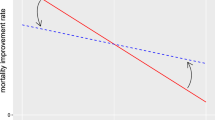Abstract
For a clear understanding of the inherent changes in mortality with advance in age, it is necessary to observe the experience of generations rather than the cross-section of period experience. In fact, the latter may produce a misleading picture as can be illustrated in the case of tuberculosis. Period experience pointed to a rise in tuberculosis death rates with advance in age, whereas generation experience indicates a decline with aging, The present paper proposes the study of mortality changes of all generations existing at one period to a subsequent period. Some characteristics and trends in the changes in generation mortality of white males and white females since 1900 are discussed. It is pointed out, in particular, that since World War II white males have been experiencing a rapidly increasing rise in generation mortality with the approach of midlife. A comparison of generation mortality changes from 1950 to 1960 among countries of traditionally low mortality shows that only males in the other English-speaking countries may be undergoing the same experience as white males in the United States upon the approach of midlife. It is not evident in the Scandinavian countries and the Netherlands and in the other countries. The reason for these differences is not apparent.
Similar content being viewed by others
References
Dublin, L. I., A. J. Lotka, and M. Spiegelman. 1949. Length of Life. New York: Ronald Press.
Metropolitan Life Insurance Company. 1962. Population profile of Puerto Rico. Statistical Bulletin (Metropolitan Life Insurance Company, New York).
Myers, R. J. 1964. Analysis of mortality in the Soviet Union according to 1958-59 life tables. Transactions of the Society of Actuaries 16: 309–317.
National Office of Vital Statistics, U. S. Dept. of Health, Education, and Welfare. 1965. Comparability of mortality statistics for the sixth and seventh revisions: United States, 1958. Vital Statistics-Special Reports, Vol. 51.
Perks, W. 1932. On some experiments in the graduation of mortality statistics. Journal of the Institute of Actuaries 63: 12–40.
Rosenwaike, I. 1968. On measuring the extreme aged in the population. Journal of the American Statistical Association 63: 29–40.
Sacher, G. A., and E. Trucco. 1962. The stochastic theory of mortality. Annals of the New York Academy of Sciences 96: 985–1007.
Spiegelman. M. 1968. Recent mortality in countries of traditionally low mortality. Proceedings of the World Population Conference, 1965, Vol. II. New York: United Nations.
Strehler, B. L., and A. S. Mildvan. 1960. General theory of mortality and aging. Science 132: 14–21.
Author information
Authors and Affiliations
Rights and permissions
About this article
Cite this article
Spiegelman, M. Segmented generation mortality. Demography 6, 117–123 (1969). https://doi.org/10.2307/2060385
Issue Date:
DOI: https://doi.org/10.2307/2060385




